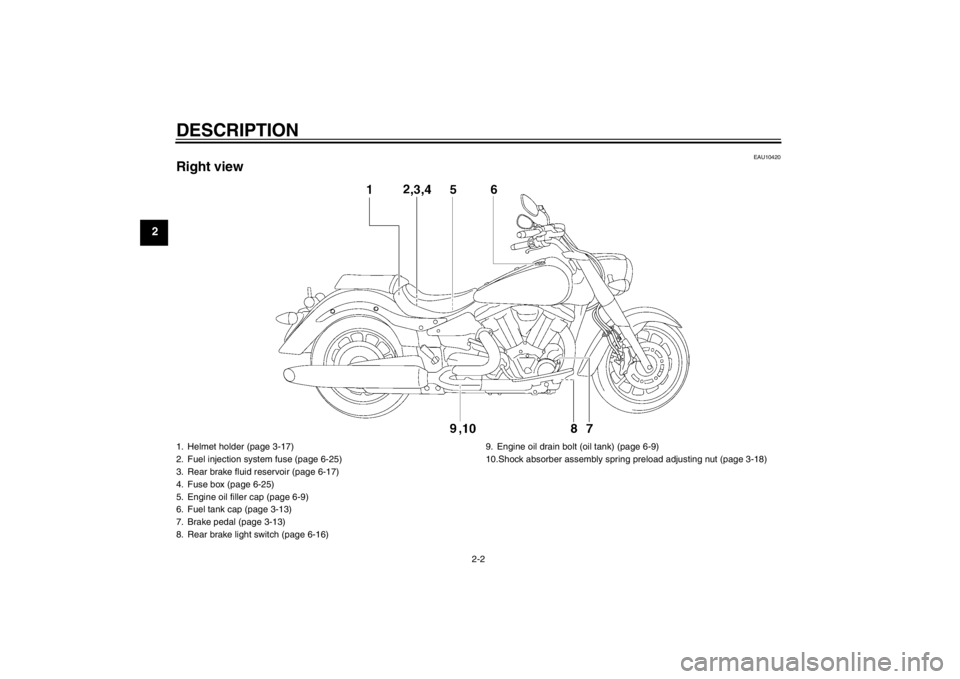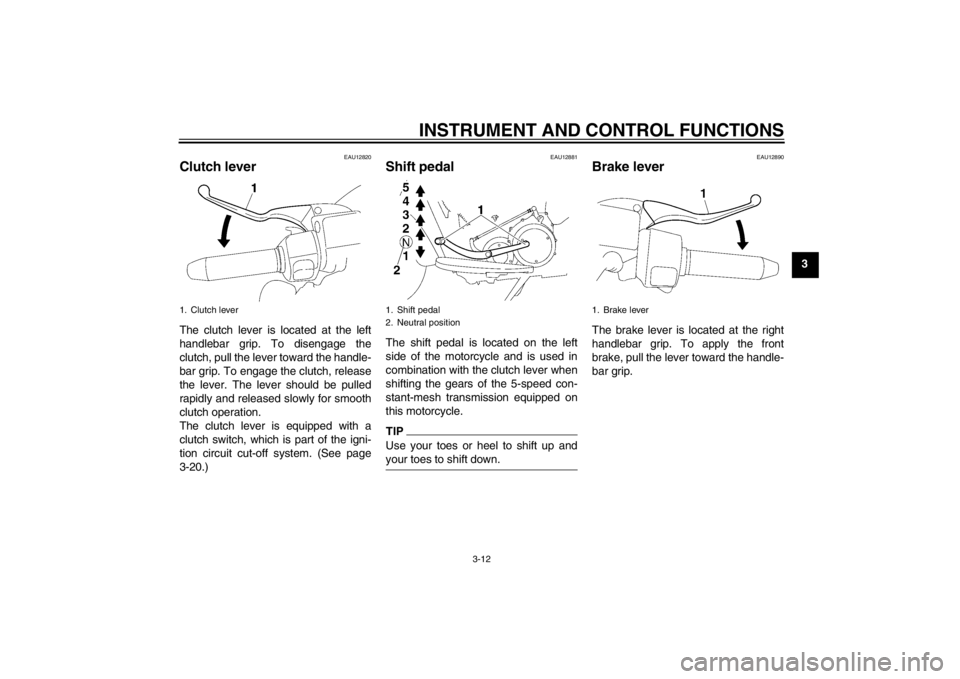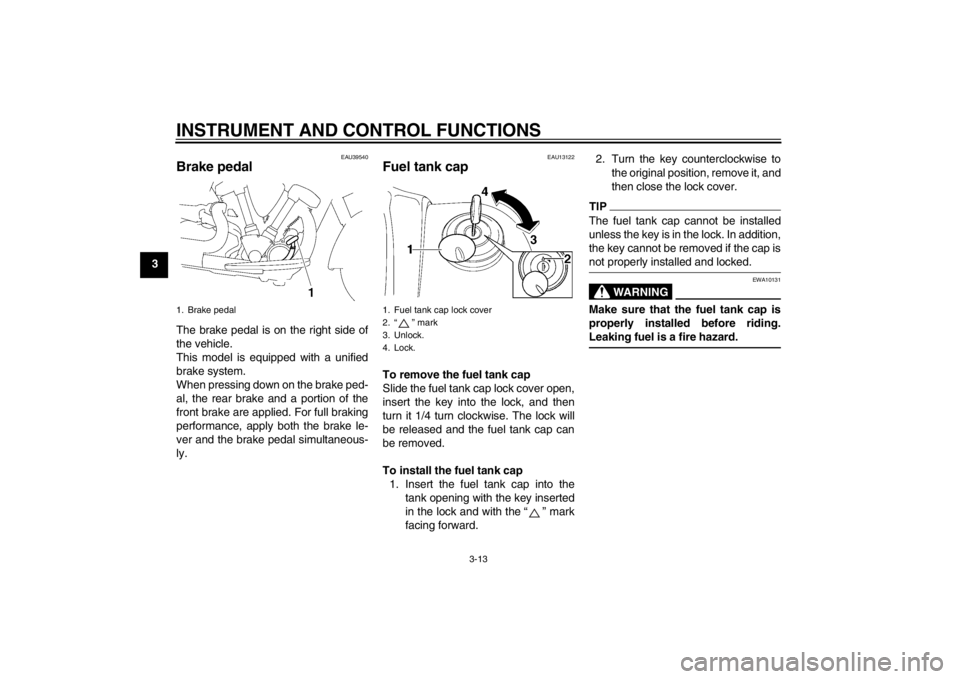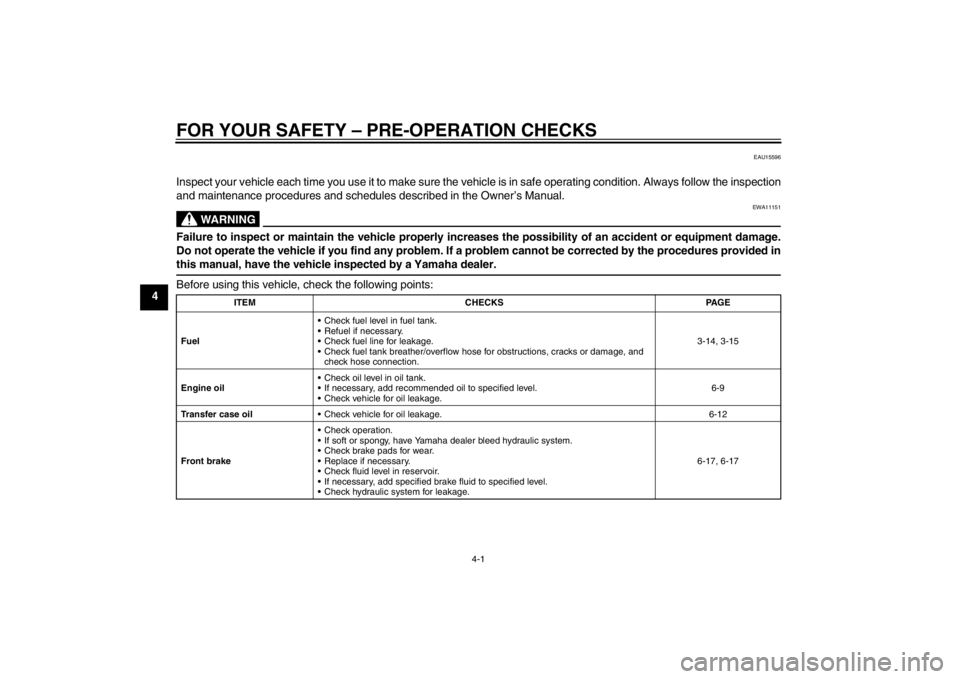brake YAMAHA XV1900A 2012 Owners Manual
[x] Cancel search | Manufacturer: YAMAHA, Model Year: 2012, Model line: XV1900A, Model: YAMAHA XV1900A 2012Pages: 88, PDF Size: 1.91 MB
Page 6 of 88

TABLE OF CONTENTSSAFETY INFORMATION ..................1-1
DESCRIPTION ..................................2-1
Left view ..........................................2-1
Right view ........................................2-2
Controls and instrume nts.................2-3
INSTRUMENT AND CONTROL
FUNCTIONS .......................................3-1
Immobilizer system .... .....................3-1
Main switch/steering lock ................3-2
Indicator lights and warning lights ............................................3-4
Multi-function meter unit .................3-5
Anti-theft alarm (optional) .............3-10
Handlebar switches ......................3-10
Clutch lever ...................................3-12
Shift pedal .... ............................ .....3-12
Brake lever ...................................3-12
Brake pedal ..................................3-13
Fuel tank cap ................................3-13
Fuel ...............................................3-14
Fuel tank breather/overflow
hose ..........................................3-15
Catalytic converter ........................3-15
Rider seat .....................................3-16
Helmet holder ...............................3-17
Adjusting the shock absorber
assembly ...................................3-18
EXUP system ...............................3-19
Sidestand ......................................3-20 Ignition circuit cut-
off system ........ 3-20
Auxiliary DC connector ................. 3-22
FOR YOUR SAFETY –
PRE-OPERATION CHECKS ............. 4-1
OPERATION AND IMPORTANT
RIDING POINTS ................................. 5-1
Starting the engine ......................... 5-1
Shifting ........................................... 5-2
Tips for reducing fuel consumption ............................... 5-3
Engine break-in .............................. 5-3
Parking ........................................... 5-4
PERIODIC MAINTENANCE AND
ADJUSTMENT ................................... 6-1
Owner’s tool kit ............................... 6-2
Periodic maintenance chart for the emission control system ............. 6-3
General maintenance and lubrication chart .......................... 6-4
Checking the spark plugs ............... 6-8
Engine oil and oil filter cartridge ..... 6-9
Transfer case oil ........................... 6-12
Air filter element ........................... 6-12
Checking the throttle grip free play ........................................... 6-13
Valve clearance ............................ 6-13
Tires ............................................. 6-13
Cast wheels .................................. 6-15 Clutch lever .................................. 6-15
Checking the brake lever free
play ........................................... 6-16
Brake light switches ..................... 6-16
Checking the front and rear brake
pads .......................................... 6-17
Checking the brake and clutch fluid levels ................................. 6-17
Changing the brake and clutch fluids ......................................... 6-19
Drive belt slack ............................ 6-19
Checking and lubricating the cables ....................................... 6-20
Checking and lubricating the
throttle grip and cable ............... 6-20
Checking and lubricating the brake and shift pedals .............. 6-21
Checking and lubricating the brake and clutch levers ............ 6-21
Checking and lubricating the
sidestand .................................. 6-22
Lubricating the rear suspension ... 6-22
Checking the front fork ................. 6-23
Checking the steering .................. 6-23
Checking the wheel bearings ....... 6-24
Battery ......................................... 6-24
Replacing the fuses ..................... 6-25
Replacing a headlight bulb .......... 6-26
Tail/brake light ............................. 6-29
Replacing a turn signal light bulb ........................................... 6-29U1CRE1E0.book Page 1 Mond ay, October 3, 2011 8:45 AM
Page 13 of 88

DESCRIPTION
2-1
2
EAU10410
Left view
1
2
8
11 10 9
3,4
5
6
7
1. Headlight (page 6-26)
2. Seat lock (page 3-16)
3. Main fuse (page 6-25)
4. Battery (page 6-24)
5. Owner’s tool kit (page 6-2)
6. License plate light (page 6-29)
7. Tail/brake light (page 6-29)
8. Engine oil drain bolt B (crankcase) (page 6-9)9. Engine oil drain bolt A (crankcase) (page 6-9)
10.Engine oil filter cartridge (page 6-9)
11.Shift pedal (page 3-12)
U1CRE1E0.book Page 1 Mond
ay, October 3, 2011 8:45 AM
Page 14 of 88

DESCRIPTION
2-2
2
EAU10420
Right view1. Helmet holder (page 3-17)
2. Fuel injection system fuse (page 6-25)
3. Rear brake fluid reservoir (page 6-17)
4. Fuse box (page 6-25)
5. Engine oil filler cap (page 6-9)
6. Fuel tank cap (page 3-13)
7. Brake pedal (page 3-13)
8. Rear brake light switch (page 6-16)9. Engine oil drain bolt
(oil tank) (page 6-9)
10.Shock absorber assembly spring preload adjusting nut (page 3-18)U1CRE1E0.book Page 2 Monday, October 3, 2011 8:45 AM
Page 15 of 88

DESCRIPTION
2-3
2
EAU10430
Controls and instruments1. Clutch lever (page 3-12)
2. Left handlebar switches (page 3-10)
3. Clutch fluid reservoir (page 6-17)
4. Multi-function meter unit (page 3-5)
5. Main switch/steering lock (page 3-2)
6. Front brake fluid reservoir (page 6-17)
7. Right handlebar switches (page 3-10)
8. Throttle grip (page 6-13)9. Brake lever (page 3-12)
U1CRE1E0.book Page 3 Mond
ay, October 3, 2011 8:45 AM
Page 27 of 88

INSTRUMENT AND CONTROL FUNCTIONS
3-12
3
EAU12820
Clutch lever The clutch lever is located at the left
handlebar grip. To disengage the
clutch, pull the lever toward the handle-
bar grip. To engage the clutch, release
the lever. The lever should be pulled
rapidly and released slowly for smooth
clutch operation.
The clutch lever is equipped with a
clutch switch, which is part of the igni-
tion circuit cut-off system. (See page
3-20.)
EAU12881
Shift pedal The shift pedal is located on the left
side of the motorcycle and is used in
combination with the clutch lever when
shifting the gears of the 5-speed con-
stant-mesh transmission equipped on
this motorcycle.TIPUse your toes or heel to shift up and
your toes to shift down.
EAU12890
Brake lever The brake lever is located at the right
handlebar grip. To apply the front
brake, pull the lever toward the handle-
bar grip.
1. Clutch lever
1. Shift pedal
2. Neutral position
1. Brake lever
U1CRE1E0.book Page 12 Monday, October 3, 2011 8:45 AM
Page 28 of 88

INSTRUMENT AND CONTROL FUNCTIONS
3-13
3
EAU39540
Brake pedal The brake pedal is on the right side of
the vehicle.
This model is equipped with a unified
brake system.
When pressing down on the brake ped-
al, the rear brake and a portion of the
front brake are applied. For full braking
performance, apply both the brake le-
ver and the brake pedal simultaneous-
ly.
EAU13122
Fuel tank cap To remove the fuel tank cap
Slide the fuel tank cap lock cover open,
insert the key into the lock, and then
turn it 1/4 turn clockwise. The lock will
be released and the fuel tank cap can
be removed.
To install the fuel tank cap1. Insert the fuel tank cap into the tank opening with the key inserted
in the lock and with the “ ” mark
facing forward. 2. Turn the key counterclockwise to
the original position, remove it, and
then close the lock cover.
TIPThe fuel tank cap cannot be installed
unless the key is in the lock. In addition,
the key cannot be removed if the cap is
not properly installed and locked.
WARNING
EWA10131
Make sure that the fuel tank cap is
properly installed before riding.
Leaking fuel is a fire hazard.
1. Brake pedal
1. Fuel tank cap lock cover
2. “ ” mark
3. Unlock.
4. Lock.
U1CRE1E0.book Page 13 Monday, October 3, 2011 8:45 AM
Page 38 of 88

FOR YOUR SAFETY – PRE-OPERATION CHECKS
4-1
4
EAU15596
Inspect your vehicle each time you use it to make sure the vehicle is in safe operating condition. Always follow the inspection
and maintenance procedures and schedules described in the Owner’s Manual.
WARNING
EWA11151
Failure to inspect or maintain the vehicle properly increases the possibility of an accident or equipment damage.
Do not operate the vehicle if you find any problem. If a problem cannot be corrected by the procedures provided in
this manual, have the vehicle inspected by a Yamaha dealer.Before using this vehicle, check the following points:
ITEM CHECKS PAGE
Fuel Check fuel level in fuel tank.
Refuel if necessary.
Check fuel line for leakage.
Check fuel tank breather/overflow hose for obstructions, cracks or damage, and
check hose connection. 3-14, 3-15
Engine oil Check oil level in oil tank.
If necessary, add recommended oil to specified level.
Check vehicle for oil leakage. 6-9
Transfer case oil Check vehicle for oil leakage. 6-12
Front brake Check operation.
If soft or spongy, have Yamaha dealer bleed hydraulic system.
Check brake pads for wear.
Replace if necessary.
Check fluid level in reservoir.
If necessary, add specified brak
e fluid to specified level.
Check hydraulic system for leakage. 6-17, 6-17
U1CRE1E0.book Page 1 Mond
ay, October 3, 2011 8:45 AM
Page 39 of 88

FOR YOUR SAFETY – PRE-OPERATION CHECKS
4-2
4
Rear brake Check operation.
If soft or spongy, have Yamaha dealer bleed hydraulic system.
Check brake pads for wear.
Replace if necessary.
Check fluid level in reservoir.
If necessary, add specified brake fluid to specified level.
Check hydraulic system for leakage. 6-17, 6-17
Clutch Check operation.
If soft or spongy, have Yamaha dealer bleed hydraulic system.
Check fluid level in reservoir.
If necessary, add specified brake fluid to specified level.
Check hydraulic system for leakage. 6-15, 6-17
Throttle grip Make sure that operation is smooth.
Check throttle grip free play.
If necessary, have Yamaha dealer adjust th
rottle grip free play and lubricate cable
and grip housing. 6-13, 6-20
Control cables Make sure that operation is smooth.
Lubricate if necessary. 6-20
Wheels and tires Check for damage.
Check tire condition and tread depth.
Check air pressure.
Correct if necessary. 6-13, 6-15
Brake and shift pedals Make sure that operation is smooth.
Lubricate pedal pivoting points if necessary. 6-21
Brake and clutch levers Make sure that operation is smooth.
Lubricate lever pivoting points if necessary. 6-21
Sidestand Make sure that operation is smooth.
Lubricate pivot if necessary. 6-22
Chassis fasteners Make sure that all nuts, bolts and screws are properly tightened.
Tighten if necessary. —
ITEM CHECKS PAGE
U1CRE1E0.book Page 2 Mond
ay, October 3, 2011 8:45 AM
Page 45 of 88

PERIODIC MAINTENANCE AND ADJUSTMENT
6-1
6
EAU17244
Periodic inspection, adjustment, and lu-
brication will keep your vehicle in the
safest and most efficient condition pos-
sible. Safety is an obligation of the vehi-
cle owner/operator. The most important
points of vehicle inspection, adjust-
ment, and lubrication are explained on
the following pages.
The intervals given in the periodic
maintenance charts should be simply
considered as a general guide under
normal riding conditions. However, de-
pending on the weather, terrain, geo-
graphical location, and individual use,
the maintenance intervals may need to
be shortened.
WARNING
EWA10321
Failure to properly maintain the ve-
hicle or performing maintenance ac-
tivities incorrectly may increase
your risk of injury or death during
service or while using the vehicle. If
you are not familiar with vehicle ser-
vice, have a Yamaha dealer perform
service.
WARNING
EWA15122
Turn off the engine when performing
maintenance unless otherwise
specified.●
A running engine has moving
parts that can catch on body
parts or clothing and electrical
parts that can cause shocks or
fires.
●
Running the engine while ser-
vicing can lead to eye injury,
burns, fire, or carbon monoxide
poisoning – possibly leading to
death. See page 1-2 for more in-
formation about carbon monox-
ide.WARNING
EWA15460
Brake discs, calipers, drums, and
linings can become very hot during
use. To avoid possible burns, let
brake components cool before
touching them.
EAU17302
Emission controls not only function to
ensure cleaner air, but are also vital to
proper engine operation and maximum
performance. In the following periodic
maintenance charts, the services relat-
ed to emissions control are grouped
separately. These services require
specialized data, knowledge, and
equipment. Maintenance, replacement,
or repair of the emission control devic-
es and systems may be performed by
any repair establishment or individual
that is certified (if applicable). Yamaha
dealers are trained and equipped to
perform these particular services.
U1CRE1E0.book Page 1 Monday, October 3, 2011 8:45 AM
Page 48 of 88

PERIODIC MAINTENANCE AND ADJUSTMENT
6-4
6
EAU1770C
General maintenance and lubrication chart NO. ITEM CHECK OR MAINTENANCE JOB ODOMETER READING
ANNUAL
CHECK
1000 km
(600 mi) 10000 km
(6000 mi) 20000 km
(12000 mi) 30000 km
(18000 mi) 40000 km
(24000 mi)
1 *Air filter element Replace. √
2 *Clutch Check operation, fluid level and
vehicle for fluid leakage. √√√√√
3 *Front brake Check operation, fluid level and
vehicle for fluid leakage. √√√√√√
Replace brake pads. Whenever worn to the limit
4 *Rear brake Check operation, fluid level and
vehicle for fluid leakage. √√√√√√
Replace brake pads. Whenever worn to the limit
5 *Brake hoses Check for cracks or damage.
Check for correct routing and
clamping. √√√√√
Replace. Every 4 years
6 *Wheels Check runout and for damage. √√√√
7 *Tires Check tread depth and for dam-
age.
Replace if necessary.
Check air pressure.
Correct if necessary. √√√√√
8 *Wheel bearings Check bearing for looseness or
damage. √√√√
9 *Swingarm Check operation and for exces-
sive play. √√√√
U1CRE1E0.book Page 4 Mond
ay, October 3, 2011 8:45 AM